Wheelie Bin
The Wheelie Bin has been increasingly used in the UK for Household Waste and Commercial and Industrial Waste since the late 1980s, replacing metal cylindrical bins at the household and metal wheeled cylindrical bins at businesses (otherwise known as a Paladin). The wheels allow for the ease of movement to and from the waste collection lorry and around the premises where the bin is based.

Background
The Wheelie Bin has been increasingly used in the UK for Household Waste and Commercial and Industrial Waste since the late 1980s, replacing metal cylindrical bins at the household and metal wheeled cylindrical bins at businesses (otherwise known as a Paladin). The wheels allow for the ease of movement to and from the waste collection lorry and around the premises where the bin is based.
The bins are generally lifted on the rear of a waste collection lorry (known as a Rear End Loader or REL Vehicle) for emptying into the compaction unit of the lorry - and the focus for the waste being collected is therefore waste that is generally light and compressible. The compressible nature of the waste therefore allows the truck to gain efficiencies through volume to weight conversion, maximising the weight able to be transported on the lorry.
Wheelie Bin Types and Sizes
The most common sizes and types of Wheelie Bin are listed below, with the smaller 120, 180 and 240 litre bins being the most common applications for Household Waste.
| Size (litres) | Max. Capacity (kg) | No. of Black Bags/Bin | General Waste Weight Max. (kg) | DMR Max. (kg) | Image | Dimensions (cm) |
|---|---|---|---|---|---|---|
| 120 Litre | 48 | 1 to 3 | - | - | 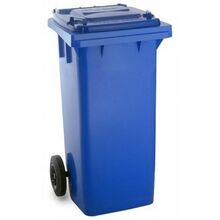 |
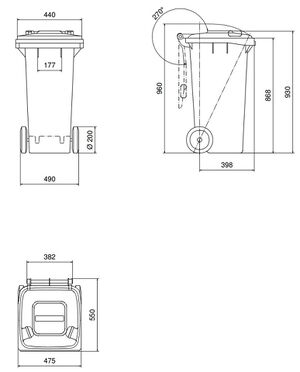 |
| 180 Litre | 72 | 2 to 4 | - | - |  |
 |
| 240 Litre | 96 | 3 to 5 | 20 | 15 |  |
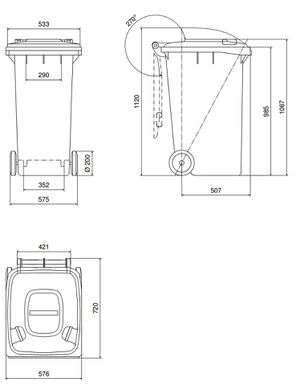 |
| 360 Litre | 144 | 6 to 7 | 25 | 20 | 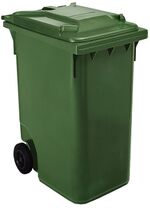 |
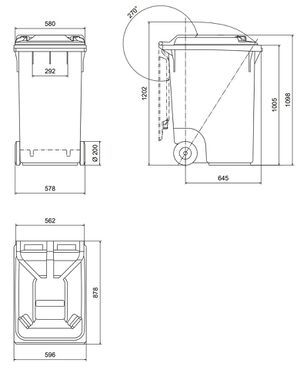 |
| 660 Litre | 270 | 10 to 12 | 45 | 30 |  |
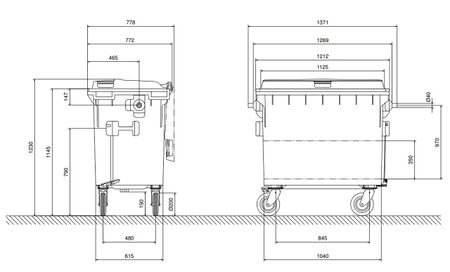 |
| 1100 Litre | 440 | 12 to 15 | 70 | 35 |  |
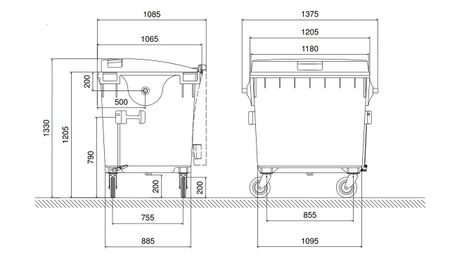 |
Configurations
Materials
Most Wheelie Bin construction is based upon molded HDPE (2), with the larger 1100 litre and 660 litre bins also available in metal.
Colours
The colour range is extensive, and whilst is broadly intended to link to the type of waste in the bin, this is by no means consistent across the UK, and indeed can be coloured to match the branding in the business collecting he waste/providing the service. However, in broad terms the following applies:
- Grey/Black Bins - Residual Waste
- Blue Bins - DMR and Recyclable Waste
- Green Bins - Green and Garden Waste (but often also used as a standard, non-branded bin colour for commercial premises)
- Red Bins - Hazardous Waste (although Biffa branding has red bins for all waste types)
- Yellow Bins - Clinical Waste
Applications
The applications can be extensive, some examples include:
- The use of smaller bins for heavy food and glass waste that does not compress, and is collected in a separate vehicle without compaction.
- The use of bins as the 'transporting unit' and not using a Rear End Loader or REL Vehicle i.e. Clinical Waste transported in the bins in a lorry/truck to the treatment center where they are emptied, cleaned and returned
- To use of bins to collect material around a large site, enabling that material to then be bought to a central point for compaction/compression for subsequent transport in the compaction bin.
